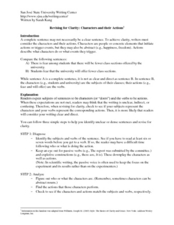Curated OER
The Wetlands
Fourth graders learn what a wetland is, where they can be found, and what types of plants, animals and characteristic are associated with the wetlands. They also participate in an activity to explore and enhance their knowledge of...
Curated OER
Waterdrops
In this science worksheet, students investigate the subject of ground water. Students read a story and articles and complete 8 pages of games and activities such as making their own sinkhole, matching, fill in the blank story and a...
Curated OER
Old Bear
Students explore different aspects of nature through a bear. In this lesson about Old Bear, students understand nature and how it all works together. Students read the story and then participate in answering discussion questions about...
Curated OER
Ice
Students examine the different propereties of ice, such as freezing temperature. In this scientific lesson students complete several activities using ice, like making ice cream.
Curated OER
Floating Plates on the Earth
Fourth graders construct a concept map about Plate Tectonics. They include types of movement, names and effects of boundaries. They research plate tectonics, describe and name 3 types. They analyze the effect on the earth's surface of...
Curated OER
Food Safety
Learners recognize that safe food preparation is important to good health. In this food safety lesson, students participate in an activity learners separate, clean, chill, and cook food safely. Students use Glo Germ to find where germs...
Curated OER
Sum of Angles on a Triangle
Use this lesson for a basic review of angles. While the activities discussed are outlined, there are no materials provided to make implementation possible. When using this resource, it is necessary to create worksheets and other...
Curated OER
To Kill a Mockingbird Details: Fun Trivia Quiz
Give this quiz to your class if you'd like to test their knowledge of ten details in To Kill a Mockingbird. This quiz is based on basic comprehension and recall of the text. While this is not the most academically challenging quiz, it...
Curated OER
Tie Dye Eggs
Students create "tie-dye" easter eggs in this easy elementary school lesson. Materials needed include paper towels, food coloring, eggs, and rubber gloves. This Easter lesson can be accomplished in 30 minutes with extra time needed for...
San José State University
Revising for Clarity: Characters and Their Actions
This handout offers a three-step process for revising sentences for clarity: diagnose, analyze, revise. After reading an example sentence revision with a detailed explanation, learners complete three sample sentences using the three-step...
NASA
Touchdown
Individuals design and build a set of shock absorbers to protect their astronauts when they land. Using a limited amount of supplies, pupils build a system that will keep two large marshmallows from flying out of a cup when it lands...
Cornell University
Catapults
Ready, aim, fire! Launch to a new level of understanding as scholars build and test their own catapults. Learners explore lever design and how adjusting the fulcrum changes the outcome.
Curated OER
Beneficial Bug Scavenger Hunt
Going on a scavenger hunt sounds like a great way to spice up any lesson plan. To better understand how beneficial insects are, the class goes outdoors to search for and observe a bug that has big benefits. Included in the lesson are...
Stanford University
Solstice and Equinox Season Model
How can December 21 be the shortest day of the year when all days are 24 hours long? Pupils see how to build a model showing the differences between winter and summer solstices and equinoxes. Using this model, classes can then discuss...
Reading Vine
Confucius: The Most Famous Teacher in China
Introduce young philosophers to the wisdom of China's most famous thinkers with a short bio. The reading comprehension passage includes an answer key.
Curated OER
My Antonia: K-W-H-L Strategy
Use the well-known KWHL chart as a tool for building up to a research project and oral presentation related to Willa Cather's My Antonia. Starting with a class brainstorm, pupils research and gradually narrow down topics relating to...
Curated OER
Mass vs. Weight
Why do you weigh more in space? Each individual in your class explores this question and others as they determine the mass and weight of different objects using two types of scales. They perform conversions and discuss their results,...
Media Education Lab
Propaganda Techniques
In an age of fake news, alternative facts, and biased reporting, it is more important than ever that 21st century learners develop the critical-thinking skills necessary to recognize, analyze and resist the propaganda techniques used in...
Curated OER
Fabric Scrap Flower Garden
Crafting is fun, it increases eye-hand coordination, and it is a great way to accent any lesson. Celebrate Earth Day by creating scrap fabric flowers for a pop-stick flower garden. Children of all ages will love gluing, cutting, and...
Michigan State University
Gases Matter
Young scientists learn that seeing isn't necessarily believing when it comes to the states of matter. After performing a fun class demonstration that models the difference between solids, liquids, and gases, children complete a series of...
University of California
Principles vs. Practices
Have you ever wondered what your own World Order would look like? Scholars use primary and secondary documents as well as video clips to investigate and analyze the Cold War. Using the sources, the principles and practices of nations...
Curated OER
Photo Essay Semester Project
Students reinforce research and organizational skills with this project. They create a photo essay and conduct an interview with a person associated with their chosen topic. Pupils may choose to get their pictures from a digital camera,...
Curated OER
Obama as a Writer
Twelfth graders examine the writings of President Obama. In this Current Events lesson, 12th graders read and analyze two articles by President Obama. Students discuss their reactions to these articles.
Curated OER
Reasons for Seasons
Students model the tilt of the Earth as it orbits the Sun. They explain the meaning and characteristics of solstices and equinoxes. They explain that sunlight hits the Earth at different angles at different locations over the course of...

























